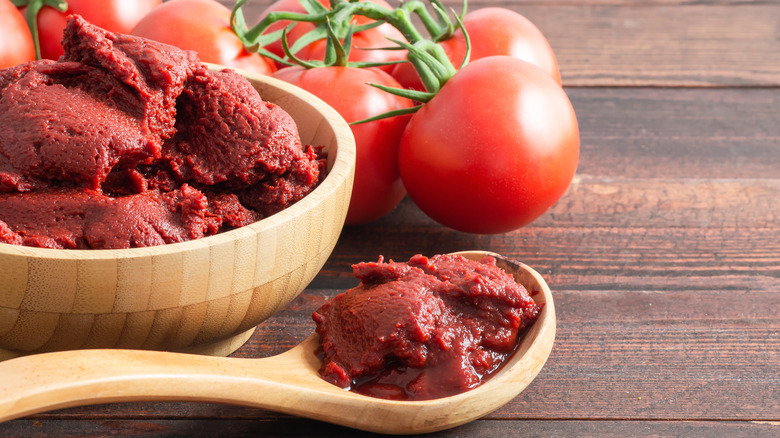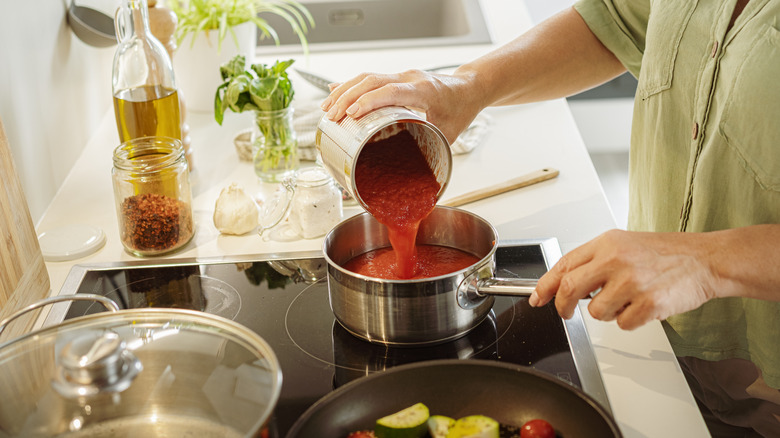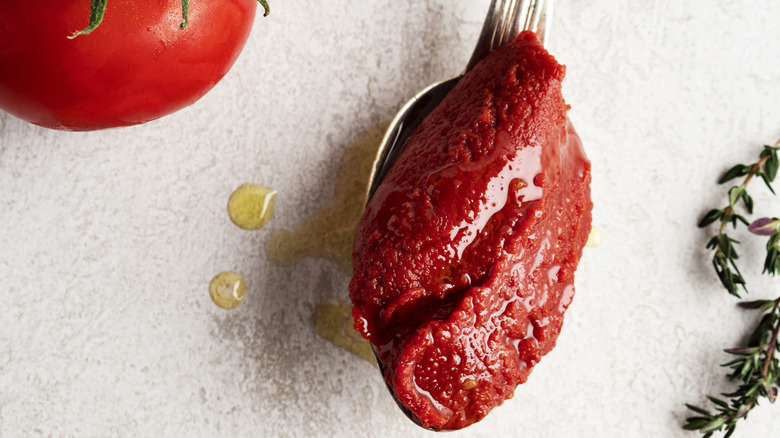The Best Substitute For Tomato Paste In A Pinch
Sometimes, it's just not worth going back to the store. It's deeply frustrating to look in the pantry and realize you've run out of those tiny tubes and cans of tomato paste — didn't you buy one last time? Though we try our best to portion and freeze leftover tablespoons of the ingredient, we all occasionally find ourselves without a drop of the concentrate.
In times like these, look for a substitute instead. Though you may have debated whether to buy whole canned tomatoes in juice or puree, we hope you bought at least one form of the red culinary vegetable. It will come in handy during emergencies.
Instead of scrapping the whole meal, swap in pureed tomato or the liquid from a can of whole or diced tomatoes. To make things easier, you can also use a blender to blitz up the canned stuff — or even a whole fresh tomato, ideally blanched and peeled — before you simmer it into a concentrated mock paste. In a pinch, tomato sauce and ketchup can also serve as substitutes, though if possible, reduce the other liquids in your recipe to avoid a watery mixture.
How to make the tomato swap
When perusing your pantry for tomato paste substitutes, first look for canned or jarred tomato products with minimal sugar and seasoning. While basil or roasted garlic tomato sauce might work in a pinch, they won't bring the same clean flavor as paste. If possible, choose crushed, whole, diced tomatoes, or a jar of passata, as these typically have the fewest additives.
The key to replicating the taste of paste is to cook down the canned juice or fresh puree until its flavor is concentrated and robust, which usually takes about 10 minutes with occasional stirring. Plan to cook down triple the amount of liquid to produce a passable substitute. In other words, use roughly three tablespoons of blended tomato or sauce to make one tablespoon of paste.
That said, some cooks swear that their marinara tastes better with a bit of sugar, so ketchup could become your next secret ingredient. If you have both fresh tomatoes and ketchup, try blending a squeeze of the condiment with the simmered tomatoes if you need multiple tablespoons. When ketchup is all you have, swap in the same amount as you would for the paste.
Replicating other aspects of tomato paste
Tomato paste is a favorite addition to braises, beans, and stews because it adds umami. Reducing tomato puree will bring your substitute closer to the long-cooked red paste, but if you're concerned about preserving that savory umami taste, consider swapping in other rich ingredients.
Add a dash of miso or soy sauce to your dinner, either as an addition or an alternative, for a savory component. Just remember that they'll add more salt, less sweetness, and no tomato flavor, so use them judiciously. And since one of tomato paste's best qualities is its ability to caramelize into an even more savory addition, try to sneak in extra browning time when preparing other vegetables and aromatics in your dish.
We also use tomato paste to thicken tomato pasta sauce, helping it cling to noodles and enhancing the eating experience. To mimic this effect, you could cook the sauce longer, but this might result in an overly salty or spicy dish as the flavors concentrate. Instead, try adding cream, a cornstarch slurry, or even pureed beans or nuts for extra body. Alternatively, take a lighter approach and add a ladle of starchy pasta water for gloss and a slight heft.



